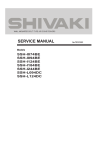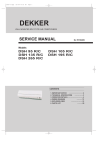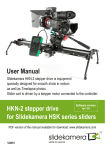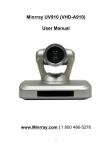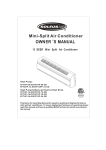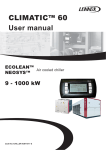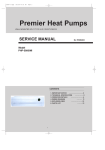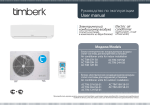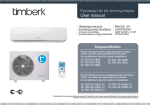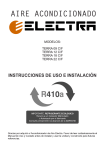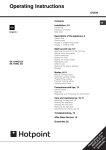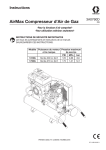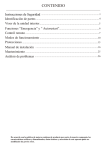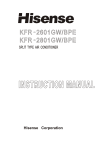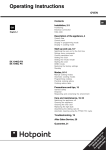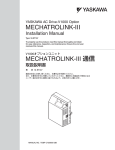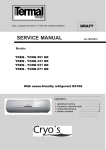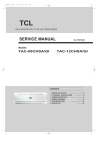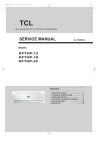Download Models SSH-I304BE/SRH-I304BE SHIVAKI SERVICE MANUAL
Transcript
OB207t-1qxp 25/9/97 8:51 PM Page 1 SHIVAKI WALL MOUNTED SPLIT-TYPE AIR CONDITIONERS SERVICE MANUAL No.TE121023 Models SSH-I304BE/SRH-I304BE CONTENTS 1. IMPORTANT NOTICE ···································2 2. TECHNICAL SPECIFICATION ·····················3 3. WIRING DIAGRAM ·······································8 4. OPERATION DETAILS ············· 9 5. EXPLOSION VIEW ····························17 6. PARTS LIST ·············19 7.ANNEX 1 TROUBLE SHOOTING Air Conditioner Service Manual IMPORTANT NOTICE This service manual is intended for use by individuals possessing adequate backgrounds of electrical, electronic and mechanical experience. Any attempt to repair the appliance may result in personal injury and property damage. The manufacturer or seller cannot be responsible for the interpretation of this information, nor can it assume any liability in connection with its use. The information, specifications and parameter are subject to change due to technical modification or improvement without any prior notice. The accurate specifications are presented on the nameplate label. How to order spare parts To have your order filled promptly and correctly, please furnish the following information: 1. Model No. with Indoor or Outdoor 2. No. in the Explosion View 3. Part Name 4. The quantity you ordered 2 Air Conditioner Service Manual Summary and features Panel Z For fixed type Models SSH-I304BE/SRH-I304BE Remarks Fixed type(220~240V/50Hz) 3 Air Conditioner Service Manual Technical Specifications Model No. SSH-I304BE/SRH-I304BE Type Control type Rated cooling capacity Rated heating capacity Btu/h;W Btu/h;W EER for cooling Btu/h.w; W/W COP for heating W/W Moisture removal Liters/h 2.2 MPa 4.5 Low(SP) MPa 1.9 High dB(A) Pressure Indoor noise level at cooling High(DP) Med. dB(A) Low dB(A) Heating Pump remote 28000;8205 28500;8350 3.02 3.42 41 Outdoor noise level Electrical Data Power supply dB(A) Voltage Range V 198~264 Cooling A 12.7 Heating Cooling Rated input Heating Annual energy consumption A W W 11.5 2715 2445 Rated current 58 220-240V~/50Hz/1P kwh (cooling) 1357.5 Refrigerating System Refrigerant/Charge Compressor Gram R410A/1720g Type Rotary Model PA270G2CS-4MU1 MFG GMCC Evaporator Hydrophilic & Louver Fin; Innergroover tube type (φ7) Condenser Louver or Corrugated Fin; Innergroover tube type φ7 Expansion device Capillary tube Defrosting system Microcomputer controlled reverse system Fan System Indoor air circulation(Cooling/Heating) m3/h 1000 rpm rpm Cross flow 1330/1230/1150 N.A Indoor fan type Indoor fan speed H/M/L Cooling Heating Dry Sleep Indoor fan motor output rpm 1150 rpm 1150 W 35 Outdoor fan type Propeller Outdoor fan speed rpm 780 Outdoor fan motor output W 76 Connections Connecting Pipe Connecting Wiring Drainage Pipe Gas Inches 5/8'' Liquid Inches Size x Core number 3/8'' 0.75x4; 0.75x2 O.D 16mm Others Indoor m2 mm 1033x313x202 Outdoor mm 902x650x307 Indoor Outdoor kg kg Indoor mm 1103x400x300 Outdoor mm 1037x705x433 Indoor kg 17 Outdoor kg 57 Suitable area Net dimensions (W x H x D) Net weight Packing dimensions (W x H x D) Gross weight 25~45 14 52 4 Air Conditioner Service Manual Louver Pipes and Power 5 Air Conditioner Service Manmual 6 OB207t-1qxp 25/9/97 8:51 PM Page 12 Air Conditioner Service Manual Product Dimensions Indoor Unit 20 mm 57 mm 400 mm C A B Outdoor Unit G F H I E J D K Unit: mm Capacity A B C D E F G H I J K 24K 1033 313 202 902 650 307 349 399 65 753.5 63 7 Air Conditioner Service Manual WIRING DIAGRAM MODEL: SSH-I304BE/SRH-I304BE INDOOR UNIT: OUTDOOR UNIT 8 Air Conditioner Service Manual Operation Details Remote controller 1 TEMP UP button Increase the temperature or time by 1 unit. 2 TEMP DOWN button Decrease the temperature or time by 1 unit. FEEL COOL DRY FAN HEAT 1 2 3 C hr DELAY ON OFF HEALTHY 3 ON/OFF button 4 FAN SPEED button To switch the conditioner on and off. To select the fan speed of auto/low/mid/high. 5 ON TIMER 6 SLEEP button To activate the function 7 SUPER SLEEP DISPLAY ECO HEALTHY RESET SLEEP . ECO button In cooling mode,press this button ,the temperature will increase 2 on the base of setting temperature: In heating mode, press this button, the temperature will decrease 2 on the base of setting temperature. TIMER ANTI-MILDEW FAN SPEED SWING TIMER button To set automatic switching-on/off. ON/OFF MODE 8 4 5 6 10 12 AUTOQUIET POWERFUL FAN SPEED AIR SWING 16 9 7 13 8 MODE button To select the mode of operation. 9 SUPER button In cooling mode, press this button, the unit will give the maximum cooling temperature with 16 In heating mode, press this button, the unit will give the maximum heating temperature with 31 . 15 9 SWING button 10 To activate or deactivate of the movement of the DEFLECTORS . 12 DISPLAY button To switch on/off the LED display (if present). 13 HEALTHY button To switch - on /off HEALTHY funtion.It is a button which controls the ionizer or plasma generator only for inverter type. 9 RESET button 15 To restart REMOTE CONTROL. Note: Each mode and relevant function will be further specified in following pages. Remote Control The remote controller is not presetting as Cooling Only Air Conditioner or Heat Pump by manufacturer. Each time after the remote controller replace batteries or is energized, the arrowhead will flashes on the front of Heat or Cool on LCD of the remote controller. User can preset the remote controller type depending on the air conditioner type you have purchased as follows: Press any button when the arrowhead flashes on the front of Cool , Cooling Only is set. Press any button when the arrowhead flashes on the front of Heat , Heat Pump is set. If you don t press any button within 10 seconds, the remote controller is preset as Heat Pump automatically. Note : If the air conditioner you purchased is a Cooling Only one, but you preset the remote controller as Heat Pump, it doesn t bring any matter. But if the air conditioner you purchased is a Heat Pump one, and you preset the remote controller as Cooling Only, then you CAN NOT preset the Heating operation with the remote controller. 9 Air Conditioner Service Manual Electronic controller: 1.Automatic mode 1) Initial RT determines the working mode and ST,the mode is determined effective only once unless A/C shut-down then re-started. If from other modes switches to autoamatic mode (including mode conversion after shutdown), it should be that the compress stop more than 3 min then temperature judgement and automatic mode are conducted (it can conduct immediately from fan mode switched to automatic, the indoor fan stops, three minutes later the response is made and start up). Within 3 min, the output as: Showing the room temperature, indoor fans starts (or anti-cold airflow), the outdoor fan stops; 2) With memory controller, once being turned off or in case of an accidently power cut, the A/C is able to retain and restore the original mode when being turned on or the power supply is resumed, if the auto restart function activated. power-down after power-on; while if the auto restart fundction isn’t activated, the A/C enters standby state. Heat pump Mode Initial RT Initial ST RT≥26℃ 23℃ Cooling 26℃>RT≥20℃ 18℃ Dehumifying RT<20℃ 23℃ Heating Cooling-only Mode Initial RT Initial ST RT≥26℃ 23℃ Cooling 26℃>RT≥20℃ 18℃ Dehumifying RT<20℃ - Ventilating Under automatic mode (including from automatic converted into dehumidifying Dry mode), when the temperature up and down signals from the remote controller is received, the setting temperature ST adjusts correspondingly to the current room temperature plus or minus 1℃, the automatic regulating temperature range is ± 2℃. 2.Cooling mode 1) The control of the compressor a. When RT-ST≥1℃,the compressor is running. b. When RT-ST<-1℃,the compressor is off. c. When -1℃≤RT-ST<1℃, the compressor keeps its original state. 2) Outdoor fan motor and the compressor run simultaneously (except for defrosting). 3) The control of indoor fan motor: a. Indoor fan motor can operate by automatic, low, middle, and high airflow speed circularly. b. Indoor fan motor’s the automatic airflow speed control Indoor fan motor can operate by automatic, as shown in Figure 1: Hi Mid Lo RT-ST 1℃ 2℃ 4℃ Figure 1 Cooling automatic airflow When the temperature changes lead to changes in airflow speed, the switch can only be made orderly, and every grade of air flow speed runs 1 minute at least. 10 Air Conditioner Service Manual 3, Dry mode running into this mode, the Air cond. firstly operates for 3 minutes according to cooling mode (set temperature is 7℃) , and then takes the detected backflow air temperature minus 2℃ as a new set temperature (the minimum value of 5℃) and runs according to cooling mode, indoor fan operates at low-speed, at this moment the setting operation of Fan speed is invalid but Swing is adjustable. 4. Heating mode On the Heating mode, the room temperature is repaired. After repaired, the room temperature display on the LED CRT=RT-3℃. 1) The control of the compressor a. When ST-CRT≥1℃,the compressor is running. b. When ST-CRT<-1℃,the compressor is off. c. When -1℃≤ST-CRT<1℃, the compressor keeps its original state 2) Outdoor fan motor and the compressor run simultaneously (except for defrosting) 3) The control of indoor fan motor: a. Indoor fan motor can operate by automatic, low, middle, and high airflow speed circularly. b. indoor fan motor’s the automatic airflow speed control Indoor fan motor can operate by automatic, as shown in Figure 2: Hi Mid Lo ST-CRT 1℃ 2℃ 4℃ Figure 2 Heating automatic airflow When the temperature changes lead to changes in airflow speed, the switch can only be made orderly, and every grade of air flow speed runs 1 minute at least. 4) Vane motor control: run as set state. 5) 4-way valve control: a. Under heating mode, the four-way valve maintains well-connected status (including the compressor stops on set condition, but except for the defrosting process) b. When the mode switches into the heating mode or start-up, four-way valves will open 5 Seconds before the compressor starts; while the mode exits from the heating mode or turn off, the four-way valve will close 2min after after the shut-down the compressor. 6) Defrosting function: During defrosting, once mode switch, temperature setting signals received, and the buzzer and display make response immediately, but the other operations won’t implemented until defrosting finished; During defrosting, the signals of on-off, timing, sleep, airflow speed ans swing will be responded, but the airflow speed and swing should be in accordance with anti-cold air rules. Except the above signal processing during defrosting, no other signals will be dealt with, but only a loud buzz. During defrosting, electrical heating stops compulsively. Defrosting enter and exit pragram: Option 1:with jumper JC The condition of enter defrosting: run into defrosting once any of condition 1, 2, and 3 met. 11 Air Conditioner Service Manual Condition 1:As shown in figure 3 Defination: The followings are all required to meet: a. IPT1 settles for IPT1=IPTmax-△IPT(8℃) b. t5≥50min(running time t5≥50min(the compressor runs cumulatively),t5 is removable,and could be less than t1) c. IPT<40℃,and lasts 2min。 Running into defrosting on condition 1, the first running time of set defrosting is F (8min); after running a defrosting cycle, the defrosting time should be determined and adjusted. Figure 3 Condition 2: When running time is more than or equal to 120 min (compressor is running accumulatively), the indoor temperature is less than 35 ° C for 2 min sustained. Running into defrosting under condition 2, defrosting time set is 8 min. Condition 3: after the compressor is operating for 20min continuously, the indoor temperature is less than 23 ° C which is anti-cold wind temperature when the fan stops running(including temperature droping when compressor operating, not including the compressor’s starting course), and the machine runs into defrosting according to any one condiciton as below) Running into defrosting under condition 3, defrosting time set is 10 min. a) Running into the first defrosting in 20 min after start-up. b) The interval from last defrosting equivalent to or more than 50 min (stopping the compressor or the machine in standby is allowed in the meantime). Option 2: No Jumper JC, and no OPT outdoor sensor when the compressor runs for 45 min, if the indoor coil temperature is less than 40 ° C for 2 min, the machine runs into defrosting, and lasts for 3min, otherwise when the compressor runs for 120 min, the machine runs into defrosting automatically and last for 10 min. Option 3: No jumper JC, but with OPT outdoor sensor When heating, when the temperature of outdoor unit under heat-exchange is lower than E ° C (-4 ° C), and the compressor runs for 45 min, then the machine runs into defrosting and last for 10 min. Option 4. When heating, when the outdoor fan motor stopped but the compressor not stopped 12 Air Conditioner Service Manual accumulative total 30min, then the machine runs into defrosting and last for 8 min. if the accumulative total less than 30min, but accord with one of the condition option 1-3 them the machine runs into defrosting at the option 1-3 and the accumulative tota time restarts from 0. Conditions for quitting defrostng (1) The quitting conditions for option 1 and option 2, the machine quits from defrosting if any one below condition met. a. Defrosring time is over. b.When it runs in defrosting for three minutes, the IPT indoor coil temperature rises 15 ° C or above from the bottom point. (2) The quitting conditions for option 3. When OPT ≥ 20 ° C or defrosting for more than 10 min, then quit from defrosting. (3) Defrosting process shown in Figure 4 Figure 4 Defrosting process 7) Auxiliary Electric heating function (1)The default condition is automatic on/off the electric heating function. (2) The conditions of auxiliary electric heating(all the following conditions must be met) a. the compressor runs for more than 3min; b. indoor fan runs normally; c. not in defrosting state; d. auxiliary electric heating is turned off for more than 30s。 e. ST-RT≥3°C; f. RT﹤22°C; g. IPT≤43°C; (3) The conditions of stopping auxiliary electric heating(any one of the following conditions met, the state stops) a. the compressor stops b. RT≥24°C; c. IPT≥48°C d. indoor fan stops。 e. running into sleeping function 5. Fan mode 1) Indoor fan motor control: 13 Air Conditioner Service Manual indoor fan motor is running at setting speed (the speed is same as that of heating). 2) Vane motor control: running according to the setting. 3) The outdoor unit is not working under fan mode. 6. Sleeping mode 1) Under sleep mode, the indoor fan motor is running at a low-airflow speed,except that the power light and sleep light are on, timer light is on/off according to the setting state, running light is off. LED is off after displaying 5min. 2) Temperature control: (1) From cool mode to sleep mode, one hour later, the operates Temp.=ST+1,another one hour later, the operates Temp.=ST+2,after then unchanged. (2) From heating mode to sleep mode, one hour later, the operates Temp.= ST-1,another one hour later, the operates Temp.=ST-2,after then unchanged. 3) the machine will automatically shut up after running 8 hours under sleep mode. Timer on start-up and sleep mode are implemented at the same time, and the sleep mode can not be functioned. 7. Timing fuction The timing scale is between 1h to 12h, the displayed time is shown by 1 hour as the unit. 8. Emergency switch(ON/OFF) 1) When stand-by, to operate by pressing the emergency switch as follows: To Press the emergency switch in three seconds, the buzzer rings once, and to release, the machine runs into cooling mode; if to holding on, the buzzer rings twince, then the machine runs into heating mode, while when the machine is on, to press the emergency Switch, the buzzer rings once and then the machine shut down. 2) The machine is running mandatorily as the selected mode within 30min after emergency operation, indoor fan motor is running in high-speed, and vane board is swinging. The machine runs into automatic mode 30min later, the selected mode unchanged, the set temperature is 23° C ,the rotate speed of indoor fan motor is automatic, and vane board is swinging too. 3) To press the emergency button when the machine operating, then the machine runs into stand-by state. 4) Under emergency operation,the Compressor’s time-lapse protection, anti-frosting protection in cooling, Overheating protection in heating and sensor fault protection and defrost operate are effective. 5) Under emergency operation, once effective signal from remote controller is received, then the machine exits form the emergency mode, and operate according to the setting from remote controller. 9. Auto-restart function 1) The PCB retains the setting parameters in case of power off. When the power supply is resumed, the machine, which has been started up the power-off memory function, is able to restore into the original running state automatically. 2) To press the emergency button and power on, and hold on 10 seconds, exit from the power-off memory function, buzzer rings four tomes.(default: no this function) 10. Protection/ Troubleshooting functions 14 Air Conditioner Service Manual 1) Compressor’s protection function: a.The PCB which has Power-off memory function, once this function is started up,the compressor goes along 3min delay protection when power on. If the PCB hasn’t been started up this function, even when the PCB is power-on, the compressor doesn’t process 3 min delay function. b.Compressor’s 3 min interval protection: the compressor can’t start-up until 3 min later(except for defrosting process). c.After the compressor started, the compressor’s state isn’t subject to the changes on ST,RT in 3min. 2) Anti-frosting protection of indoor evaporator: If IPT ≤ 0 ℃ detected in consecutive 5 min, compressor and outdoor motor stoped, indoor fan motor runs at high-speed forcibly; IPT ≥ 5 ℃ detected 3min later, then outdoor fan is activated. And the compressor, indoor fan motor restores the original state. 3) Overheating protection: IPT ≥ 55℃, the outdoor fan stops, IPT ≥ 65℃, the compressor stops, indoor fan motor runs at high-speed forcibly. When IPT ≤ 48℃, outdoor fan motor and the compressor open, indoor fan motor restores the original state. 4) Anti-cold wind control in heating: a. When runing into the heating mode, once the compressor fails to comply with the start-up conditions, the wind speed is regulated according to the coil temperature in 2 min(including stopping the indoor fan motor), 2 min later the indoor fan motor stops.If the compressor starts up within 2 min, then operating by Figure 5. Under heating process, to close the compressor (including the downtime protection ), the wind speed is regulated according to the coil temperature in 1min(including stopping the indoor fan), 1min later the fan is stoped forcibly. b. When the indoor fan motor running at a low-speed wind and in anti-cold wind operation, once electric heating opens,the vane immediately withdraws from the anti-cold windy location and turn back to normal vane angle. When electric heating closes, indoor fan motor go on to run at low-speed wind, accordingly, the vane turns to anti-cold windy location. Figure 5 Anti-cold Wind 2) The following table shows the fault protections. When failures happens, the PCB alarms and buzzer rings three times. Failure code appears, and the PCB operates protection procedures. 15 Air Conditioner Service Manual Failure code: For the machine has LED, the code displays on LED, for no LED machine, the code reflects by the running light. Failure Running Light Flash LED Display RT Sensor Failure Once / Period E1 IPT Sensor Failure Twice / Period E2 Indoor Fan Motor Failure 6 times / Period E6 When there is LED displaying failure code, the code is displayed statically, if there are several failure codes should be reported at the same time, then failure codes appears one by one every eight seconds correspondingly. a. Sensor’s failure protection: when the sensor’s temperature is out of the range -50 ≤ T ≤ 110 ℃, then sensor failue is determined. Once RT, IPT sensor failures appear, the compressor stops and indoor and outdoor fan motors shut off. Remote controller deesn’t response to any signal except for shutdown. During failure the machine can run in fan mode. After the failure is settled, the PCB restores to standby status. b. Failure protection of Indoor PG fan motor:If there is no feedback signal of rotate speed within 5, the indoor fan motor stops,at the same time, the compressor, outdoor fan moto, four-way valve and auxiliary electric heater etc cut downn. 10 seconds later, the indoor fan motor restarts, once there is no feedback signal of rotate speed within 5 seconds either, then the machine stops and goes into indoor fan motor failure protection, buzzer rings three times, and running light flashes at 6 times per 8 seceonds. When the failure is confirmed, once there is feedback signal,the failue is relieved automatic. 16 Air Conditioner Service Manual EXPLOSION VIEW Mode: SSH-I304BE INDOOR UNIT: 1 27 2 3 26 4 5 25 6 24 23 7 22 8 21 9 10 11 20 12 19 18 13 17 14 16 15 17 Air Conditioner Service Manual EXPLOSION VIEW MODEL: SRH-I304BE OUTDOOR UNIT: 7 6 4 5 3 1 2 27 26 8 25 24 23 9 22 21 20 19 18 17 10 11 12 18 13 14 15 16 Air Conditioner Service Manual Indoor Unit- SSH-I304BE No. 1 2 3 4 5 6 Part No. 1080030001 1070701047 1070020014AA 1070100010 1110050321 1070701048 Part Name Installation Plate Base Cross Fan Bearing Mount Evaporator Water Drainage Assembly Q’ty 1 1 1 1 1 1 7 1070701050 Vertical Vane Assembly A 1 8 9 10 1070701051 1070701069 1070701062 1090500501 Vertical Vane Assembly B Face Frame Screw Cover Display PCB 1 1 3 1 1073090126 1070190058 1070190059 1070500698 1071990077 1073090114 1070701052 1070701053 1070110011 1070040003 1170020041 1073030201 1090700403 1073090120 1 1 1 1 1 1 1 1 1 1 2 1 1 1 1 1 1 1 1 1 1 1 1 1 1 11 12 13 14 15 16 17 18 19 20 21 22 23 24 25 26 27 1170030048 1070701450 1173090107 1170230001 Display PCB Box Left Air Filter Right Air Filter Front Panel Display PCB Cover Electrical Box Cover Vane A Vane B Drainage Hose Cable Clamp Vane Motor Sensor Holder Main PCB Indoor Motor Cover Indoor Motor Electrical Box Transformer Indoor Sensor Assembly 28 29 30 31 32 33 34 1090050298BU 1070060003 1190060003SA 1190060070 1190060069 1190060002 1190060021 Remote Controller Remote Controller Supporter Indoor Carton Left Foaming Right Foaming Middle Pasteboard Supporter Middle Foaming Supporter 19 Remark Not shown in Explosion view Air Conditioner Service Manual Outdoor Unit- SRH-I304BE No. 1 2 3 4 5 6 7 8 9 10 11 12 13 14 15 16 17 18 19 20 21 22 23 24 25 26 27 28 29 30 31 32 Part No. 1071990041 1081990038 1110061755 1081990042 1170040102 1170120146AA 1081990040 1081990047 1071990045 1100011034 1120110017 1120640340 1081990178 1081990039 1120120024 1081990041 1120130037 1070350971 1074060118 1170200054 1170100030 1170100025 1080010006 1081990049 1174561801 1120640341 1081990050 1174561802 1190500707PW 211310615 211310616 1190060191 Part Name Grille Top Cover Condenser Outdoor Motor Supporter Outdoor Motor Propeller Fan Left Grille Supporter Front Plate Fan Guad Compressor And It Accessories 4-way Valve 4-way Valve Assembly Base Right Plate Two-way Valve Valve Supporter Three-way Valve Electrical Box Cover Cable Clamp Terminal Fan Motor Capacitor Compressor Capacitor Capacitor Strip Electrical Parts Box AC Contactor Capillary Assembly Partition plate Outdoor Sensor Cabinet Carton Upper Foaming Base Foaming Base Carton 20 Q’ty 1 1 1 1 1 1 1 1 1 1 1 1 1 1 1 1 1 1 1 1 1 1 1 1 1 1 1 1 1 1 1 1 Remark Optional Not show in the explosion Air Conditioner Service Manual ANNEX 1 TROUBLE SHOOTING INDEX 1. Electric parts 2. Refrigerant system 3. Troubleshooting 4. Installation Fundamentals Air Conditioner Service Manual 1. Electric parts It is compressor and motor fan that finally drives after power is supplied. And it is necessary to check the internal factors like switches, protectors, or lead wires that are needed to reach the compressor and motor fan to see if their connections are normal and the external factors to see if voltage is normally supplied. 1.1 External factors check 1) Working power and voltage drop The rated voltage for airconditioner is specified in a workable range. In order to operate airconditioner normally, it is desirable for the working voltage and minimum. starting voltage to be within the following chart range. Especially, just the fact that the voltage when airconditioner is not at work is within the working voltage range is insufficient, and the voltage is sure to be within the working voltage range by measuring in a operating condition. lnput voltage (V1) * Usable voltage = Product rating ±10% Voltage Voltage drop Starting voltage(V2) Running voltage(V3) Time 2) Electric wire capacity The electric wire for airconditioner should have an allowable current more than the load current of the circuit and be able to control the voltage drop by the load current within 2%. And it should be a thickness capable of keeping the voltage drop by a starting current within -10%, and especially for an airconditioner of single phase, the voltage drop (Flicker voltage) by the starting currnet be within about 5%. A = V1 - V2 : Voltage drop by the starting current of airconditioner (Flicker voltage) B = V1 - V3 : Voltage drop by the normal running current of airconditioner V1 - V3 X V1 V1 - V2 100 ≤ 2%(B case) X V1 100 ≤ 5%(A case) In case of using an airconditioner in a low voltage area where power supply voltage is low, especially, the Flicker voltage due to inadequate wires may cause the fluorescent light to be off or may affect the other electric products. So, care should be taken to the wiring work. 2 Air Conditioner Service Manual 3) Wire thickness required Rated current appliance(A) Nominal cross-sectional area(mm2) Up to and including 6 0.75 Over 6 up to and including 10 1.0 Over 10 up to and including 16 1.5 Over 16 up to and including 25 2.5 Over 25 up to and including 32 4.0 Over 32 up to and including 40 6.0 Over 40 up to and including 63 10.0 For rated currents up to 3A, a nominal cross-sectional area of 0.5mm2 is only allowed if the length of the cord does not exceed 2m. 1.2 Internal factors check Power supply Switches • Operation switch • Rotary switch • Remocon Function parts Protector • Operation indicator lamp • Relay • reversing coil • Conductor • Thermistor • Pressure switch • O.L.P • Fuse Compressor Motor Fan 1.2.1 Insulation resistance Measure the insulation resistance between live part and dead metal part by 500V insulation resistor to check if the insulation resistance is more than 10MΩ. 1.2.2 Insulation resistance measurement of compressor Measure the insulation resistance of compressor between compressor terminal and dead metal part by insulation resistor, and the insulation resistance should be above 10MΩ. Compressor may change the insulation resistance while running. Accordingly, measure the insulation resistance just after running as needed. • Note: For R-22 used in airconditioner, the dielectric rate on liquid state is high. If a contaminant is mixed into R-22, the electric resistance is extremely low and the poor insulation is occurred. Accordingly, be sure to prevent contaminants from mixing into refrigerant system. 3 Air Conditioner Service Manual 1.2.3 Running capacitor 1) Earth inspection between terminal and body As shown in Figure 1, connect a resistor between one side terminal and body of condenser to check for continuity. 2) Capacity inspection (1) Remove the lead wire from both terminals of condenser to be checked. (2) Contact both terminals of lead wire for 2-3 sec., and discharge. (Be sure to perform to prevent the tester damage before measuring.) (3) After discharging, contact both terminals of tester with the terminal of condenser to see the dial vibrating direction of resistor. (See Figure 2.) There are three kinds of dial vibrating direction in tester, and each vibrating direction and symptom is as follows. A: Normal : Dial shakes instantaneously and returns to the original state immediately. B: Short : Dial remains moved. C: Capacity consumed up : Dial does not move at all. Figure 1. Figure 2. 1.2.4 Motor fan 1) Power off, remove motor fan, and test independently. 2) Measure the resistance of main coil, sub coil and control coil in motor. 3) Use a good quality of capacitor in testing. 4) Diagnose the following troubles by the independent test, and replace motor. a) Motor is not started. b) Motor rotation rises very slowly. c) Bearing failure : The shaft does not move. d) Arc occurs in the motor inside. e) Smoke emits from motor inside. f) Excessive noise 4 Air Conditioner Service Manual Measuring main coil resistance : White ↔ Black Black Measuring sub coil resistance : Brown ↔ Black Brown O.L.P Red C S Measuring control coil resistance : Red ↔ Black White M 1.2.5 Thermostat There are 3 kinds of thermostat malfunction. 1) Leak of gas charged in sensor part 2) Short of contact point 3) Wrong wiring Switch off at room temperature 18-30°C, turn carefully the knob of thermostat from 1 to 10 (the number may be different or a figure be used according to model) or reversely, and click sounds. After the sound is heard, turn reversely to check again the click sounds. If click sounds, the thermostat is in normal. If room temperature exceeds 30°C, test should be done after cooling by putting the sensor part of thermostat into a cold water container because the contact point is not opened. If knob is turned but click does not sound, remove the thermostat cover and examine the contact point. The fused contact point should be replaced with a new thermostat. If contact point is not closed despite of the sensor temperature being sufficiently high, the gas at the sensor part may be leaked. In this case, replace the thermostat. When replacing thermostat, be sure to conduct after performing carefully as the above content. 1.2.6 Thermistor Pull out the lead wire of thermistor terminal to test continuity. Connect a tester to the terminal of thermistor and measure the resistance. The resistance value varies according to the measuring condition and temperature, so in order to vary temperature forcibly, put water in a cup, cool the sensor part of thermistor, and then measure the resistance, and also measure in a condition that the sensor part of thermistor becomes warm by hands. 5 Air Conditioner Service Manual 1.3 Compressor trouble diagnosis 1.3.1 Electrical troubles 1) Ground test Test single phase and three phase in the same manner. (1) Shut off the power supply to product. (2) Remove the wires connected to the compressor terminal. (3) Clean the compressor terminal and discharge (suction) pipe. (4) Measure the resistance of discharge (suction) pipe and each terminal by using a R x 1K scale of Ohm meter. Ohm Meter R x 1K (5) If dial moves remarkably, the terminal is in ground state. So, replace the compressor. 2) Wrong wiring check of compressor terminal Examine the wiring diagram of compressor terminal or the electric circuit diagram of product on the cover of compressor terminal to check if there is wrong wiring. 3) Checking of wire disconnection or overload protector (O.L.P) operating condition This check is to see the wire terminal condition of motor inside, and for a single phase compressor with O.L.P built-in, it identifies the O.L.P operating condition and wire disconnection. (1) Shut off the power supply to product. (2) Remove the wires connected to the compressor terminal. (3) After checking the ground state, cool the compressor sufficiently. (at room temperature) <For single-phase compressor> (4) Measure the resistance of each terminal by Ohm meter R x 1K scale, and if dial does not move, compressor is in opened condition. <For three-phase compressor> (5) Measure the resistance of each terminal by Ohm meter R x 1K scale, and if dial does not move, the wire between two terminals is disconnected. -> Action: Replace the compressor. * OLP may be operated by the following causes, so be sure to find and remove the cause. (1) Operation at low voltage (2) Defects of operation or starting device (3) Overheat of compressor motor due to the condensing coil closing, condensing motor defects, liquid line close, or injection capillary close. 6 Air Conditioner Service Manual 1.3.2 Mechanical troubles 1) Not starting (1) Phenomenon : Compressor is not started but the starting current continues to flow. (2) Checking a) Check capacitor. (for a type where a capacitor for compressor starting or operating is used) b) If there is no trouble, it is judged as lock due to the wear of compressor inside or the damage of lubricating device. Replace the compressor. 2) Poor compression (1) Phenomenon : Compressor is at work, but the cooling capacity is weak, the pressure of high pressure side is low and the pressure of low pressure side is high. (2) Cause : Damage of valve in compressor inside, damage of connecting rod or crank shaft, or other internal leak (3) Checking a) Stop and then start the condenser fan, and if the pressure of high pressure side does not increase, the compressor is bad. b) Measure the temperature of discharge pipe in compressor, and if it is abnormally low temperature (50°C or less), the compressor is bad. c) Conduct the pump down test of system to check the compression capacity. - Power off the product. - Close the service valve of liquid line. (Rotate the valve rod clockwise to close the valve rod.) - Start product and observe the suction pressure. - If compressor is normal by pumping down the system, pressure is kept 0-5 psiG (0-0.35kg/cm2.G), and if the suction pressure increases, the compressor is bad due to the internal leak or valve damage. (4) The compressor to be assumed as bad compression should be replaced. If running for a long time in a bad compression condition, abnormal superheat may occur and the compressor motor is burnt. - Clean the cycle. 3) Overcurrent flowing while running Check the working pressure, and if there is no trouble, it is assumed as the compressor bearing damage. Replace the compressor. (Excessive refrigerant charging may cause the overcurrent.) 7 Air Conditioner Service Manual 2. Refrigerant system 2.1 Refrigerant system troubleshooting Check the following items when troubleshooting the refrigerant system. 1) The thermostat setting or remocon temperature setting is not wrong? 2) Air filter is not cleaned? 3) Blower fan control switch is not at "low"? 4) Ventilation lever is not opened? 5) There is no obstacle in suction or discharge side of outdoor unit? 6) Dirty heat exchanger causes the heat exchanging efficiency to be down? (Thorough cleaning) 7) Cooling/heating load is not increased? 8) Too many persons are in room? (Cooling) 9) The insulation of window gap is not wrong? If there is no trouble from the above checks and also if there is no trouble on the electric appliances of airconditioner body, it is assumed as refrigerant system failure. a) Set aircon to High cool, run cooling for 15 min. or more, and measure the temperature difference of suction/discharge air in indoor unit. (Adjust the wind direction so that wind is discharged to the front direction in the installed condition.) b) Measure the voltage and current in running condition. c) Measure the pressure of low pressure side in cooling condition. (If the temperature is low, convert into the test switch.) 2.1.1 Temperature difference and current of suction/discharge air in evaporator Temperature difference of suction/discharge air Running current measurement No temperature difference. 80% or less of rated current. -- Gas leak (almost) Refrigerant cycle closed Temperature diff.: Under 8°C. 80% or less of rated current. -- Gas leak, refrigerant cycle closed, bad compressor Temperature diff.: Under 8°C. Rated current or over. -- Excessive refrigerant charging Temperature diff.: 8°C or over. -- No refrigerant cycle trouble • Temperature difference of suction-discharge air Normally, the temperature difference is based at 10°C. Actually, the judgemnt criteria is 8°C, because when the room humidity is high, the temperature difference is small and when humidity is low, it becomes large. 8 Air Conditioner Service Manual 2.1.2 Pressure and temperature of refrigerant P1 Capillary Tube Accumulator Outdoor Side Compressor P2 Evaporator Indoor Side High pressure (Liquid side)tube Low pressure(Gas side) tube Compressor The pressure in normal condition shows the figure in the right side table, but the pressure (P1) of high pressure side tube is affected greatly by the temperature change and about 16kg/cm2.G in a low temperature condition (indoor/outdoor 21°C). Measuring place Pressure(kg/cm2 G) P1 About19.5 P2 About 5.0 The pressure fluctuation is affected by the tube length or insulation as well as temperature change, so measure the pressure (P2) of low pressure side for the trouble shooting of refrigerant system. <Trouble finding by pressure/temperature> Pressure (than normal) Temperature (than normal) Higher Higher Normal Lower Cause Bad compression: Compressor failure, Bad reversing Valve Explanation Current flows weakly. Cooling load is small. Current flows weakly. Liquid refrigerant suction: Excessive refrigerant charging High pressure is not increased rapidly in early running stage. Gas short : Gas leak Current is low. Closed : Pipe internal Current is low. Higher Note) The high/low temperature is a figure converted into pressure. The low pressure is normally 4.5-6.0kg/cm2G. (Temperature is normally 3°C-10°C.) 9 Air Conditioner Service Manual • Pressure measurement of low pressure side Closed Closed As shown in Figure above, connect the manifold gauge to the low pressure (gas side) tube of condenser and measure the pressure. 2.1.3 Symptoms and actions 1) Short of refrigerant The short of refrigerant appears in a slightly different symptom as (1) no refrigerant or (2) short of refrigerant. (1) Symptoms : The temperature difference of suction-discharge air is 8°C or less, the running current is less than the rated current, and the pressure of low pressure side is low. (These are symtoms changed by short of refrigerant.) (2) Judgement method : Frost is formed from the capillary tube outlet to the evaporator inlet. The suction pipe of compressor is not cold. (The temperature of suction pipe is similar to the outdoor temperature.) The pressure of low pressure side in cooling is 4kg/cm2.G or less. (Surrounding temperature : 30°C or over) Refrigerant oil comes out from the evaporator-condenser connections and each welded portion. (Finding the gas leak place) (3) Actions: ➀ Find the gas leak area. (Check at balance pressure of 5kg/cm2.G or over.) ➁ Charge refrigerant to the specified level. ➂ Check for gas leak. 2) Closing of refrigerant system (1) Symptoms : If the refrigerant system of strainer or capillary tube is closed, pressure drops at the outlet of closed area, and refrigerant evaporates to form and attach dew or frost. The running current is less than the rated current, and the pressure of low pressure side is lower than the normal. If completely closed, the pressure of low pressure side is to be 0kg/cm2.G as time goes by. (2) Judgement method : The same symptoms as the short of refrigerant appears, and the same phenomenon occurs even if refrigerant is sealed. It takes 3 min. or more for refrigerant to balance. If running in the condition, the temperature of discharge gas becomes higher, the refrigerant oil is deteriorated, and the life time may be affected. (Compressor motor may be burnt.) 10 Air Conditioner Service Manual 3) Overcharge (1) Symptoms : • The temperature difference of suction-discharge air is 8°C or less, the running current is higher than the specified current, the pressure of low pressure side is high, and the compressor and suction pipe are cold. If running in the condition, pressure switch activates at overload operation to make continuous operation impossible, compressor is difficult to start, and fuse or breaker is easy to be disconnected. (2) Actions : ➀ Dischage the refrigerant. (By 3-5kg/cm2G) ➁ Charge refrigerant to the specified level. ➂ Check for gas leak. 4) Bad compression (1) Symptoms : • The temperature difference of suction-discharge air is little, the running current is less than the specified current, the pressure of high pressure side is low, and the pressure of low pressure is high. (2) Judgement method :• Close service valve of high pressure side in condenser (front seat) and connect the manifold gauge to the service valve of low pressure side. (Close the valve.) • If the dial of pressure gauge does not indicate 0kg/cm2G or less by cooling in the condition, the compressor is judged as bad. Liquid side tube Outdoor Unit Low Gas side tube High Compressor Indoor Unit Note) If pressure gauge is near 0kg/cm2G, immediately stop the cooling. Otherwise, air flows into the refrigerating cycle or the compressor motor coating is taken off to cause the poor insulation. So, care should be taken. 11 Air Conditioner Service Manual 2.1.4 Summary of check items by cause Check item Cause Suction/discharge air temp.diff. of evaporator Rated current Cooling 8°C Heating 14°C Cooling Heating Low pressure High pressure Cooling Heating Cooling Heating Short of refrigerant ¢ ¢ ¢ ¢ ¢ ¢ ¢ ¢ Capillary closing (a part) ¢ ¢ ¢ ¢ ¢ ¢ ¢ ¢ Outdoor heat exchanger contaminated ¢ ¢ ¢ ¢ ¢ ¢ ¢ ¢ Indoor heat exchanger contaminated ¢ ¢ ¢ ¢ ¢ ¢ ¢ ¢ Bad compressor ¢ ¢ ¢ ¢ ¢ ¢ ¢ ¢ 2.2 Precautions on repair 1) When discharging refrigerant (from pipe or body), the discharge outlet should direct the direction where nobody exists. 2) Do not work near fire or flame. 3) Work in a large space if possible and arrange the scaffold. 4) Especially for working on rooftop, prepare a place to keep tools and take care to prevent from falling. 5) While running (pump down work, test run), do not insert hands into fan. 6) Clean the Indoor-outdoor connecting pipes and the manifold gauge edges to be free from dust or moisture. 7) Be sure to fill refrigerant to the specified level. (If refrigerant is too much or short, the capacity is down and trouble may occur.) 8) Keep tools well, and check the measuring machine periodically. 12 Air Conditioner Service Manual 3. Troubleshooting 3.1 Product does not operate at all. Power supply voltage check Power input voltage Driving load terminal Display PCB connector Power receptable voltage Product input voltage Evaportor-condenser connecting pipe PCB assy (fuse, varistor, pattern) Connector contact check Power trans output voltage PCB assy check 13 AC about 14±3V (General model) Air Conditioner Service Manual 3.2 Room fan does not operate at all. Connector contact check Motor bearing inserted state Fan(Blower) fixed state Fan(Blower) contact state Motor output connector Motor capacitor Motor-related parts check Motor detail check Coil resistance (TP) Motor capacitor Motor insulation resistance Error code check Communication effor Blower lock sensing Operation mode check PCB ass'y check Motor driving circuit Relay output 14 In dehumidifying, heating, or artificial intelligence operation, room fan may be off. Air Conditioner Service Manual 3.3 Compressor or outdoor fan does not operate at all. Re-input after power off Set the desired temperature of remocon to be lower by 2°C or over than room temperature, and start the cooling operation. Does not operate at all. Repeat running/stopping at a short time period. Temperature sensor open/close check Thermistor and evaporator surface contact check. - Clearance is needed (5mm). Connector check (Contact & power) Connector check (Contact & power) Disconnection/short circuit check of connecting wire OLP/High pressure switch/ Low pressure switch check Electric wire connection check for outdoor side Operation mode (dehumidifying) check Compressor & motor detail check Insulation resistance Coil resistance Capacitor capacity Compressor OLP PCB assy check Temperature sensing circuit Relay output 15 Air Conditioner Service Manual 3.4 Up/down vane does not operate at all. Vane bending, structures interferance check Motor shaft assembly check If a constant torque is felt when rotating vane by hands, the assembled condition is normal. Connector check (Disconnection/short circuit/malconnection) Blower operating condition check At the moment the blower is stopped, up/down vane auto switch is stopped, and if blower is started, auto switch is re-operated. - Especially, it occurs while dehumidifying or heating. PCB ass'y check Step motor driving circuit 16 Air Conditioner Service Manual 3.5 Left/right louver does not operate at all. Louver/link/cam assembly check Motor shaft assembly check If a constant torque is felt when rotating louver by hands, the assembled condition is normal. Connector check (Disconnection/short circuit/malconnection) Blower operating condition check At the moment the room fan is stopped, louver auto swing is stopped, and if room fan is started, auto swing is re-operated. - Especially, it occurs while dehumidifying or heating. PCB ass'y check Step motor driving circuit Synchronous motor driving circuit 17 Air Conditioner Service Manual 3.6 Function setting by remocon is disable. Power input after power off Operation ON by remocon - If there is no remocon transmission signal, check the battery or remocon operation. - If product receiving is not checked, check the display PCB. • UCheck the transmission signal of remocon - Liquid crystal remocon: signal blinked - Button remocon: LED blinked • UCheck the product receiving - Buzzer sounds. Switchover the air flow by remocon. - In cooling mode, if compressor is stopped, blower is operated at low fan. - In dehumidifying mode, to enhance the dehumidifying effect, blower is operated at low fan. - In heating mode, blower is stopped or operated at low fan according to the situations (defrosting, hot start, compressor off). - In Sleep operation mode, blower is operated without switched-over (low or middle fan). - In artificial intelligence mode, room fan switching-over is not possible by remocon. PCB ass'y check Display PCB assy check - Connector/damage 18 Air Conditioner Service Manual 3.7 Cooling/heating conversion is disable. Heating operation ON by remocon If the reversing valve (4-way valve) is ON, "tick" sounds. Connector check 4-way valve connection check outdoor unit connecting wire check PCB ass'y check 4-way valve relay output = ON Switchover into cooling operation by remocon, and after about 30 sec., check the 4-way valve relay output = 4-way valve OFF If 4-way valve is OFF, the refrigerant flowing sounds (pee....) due to cycle switchover occurs. 4-way valve coil resistance check 19 Air Conditioner Service Manual 4. Installation Fundamentals Case-1 Leakage /Freon - 1/4 Key Factor Troubles & Causes Pipe cutting Gas leaks due to the mal-flared copper pipes with non-rectangular section. Defect Details Pipe cutter Cutting curved pipe leads mal-rectangular section. And it makes gas leakage. Cu. pipe Guidelines Pipe cutter 90˚ Make pipe straight before cutting, and it makes a rectangular section. Cu. pipe 20 Air Conditioner Service Manual Case-2 Leakage /Freon - 2/4 Key Factor Removing burrs of pipes. Troubles & Causes Gas Leaks due to the burrs caused by cutting and not removing properly. Defect Details Burrs not removed properly after cutting. • Flaring the pipe with burrs(not removed after cutting) can make freon gas leakages. • Burrs won't make smooth contacting surfaces. Guidelines Reamer • Burrs should be removed clearly with REAMER. • Only clean surfaces prevent gas leakages. 21 Air Conditioner Service Manual Case-3 Leakage /Freon - 3/4 Factor Flaring works Troubles & Causes Gas leaks and connecting troubles on tubings caused by the inaccurate sizing during flaring works. Defect Details Pipe worked with large sized b won't be assemsled into the nut. b Pipe worked with small sized b will make small contact with nut and gas leak against even a weak shock. Guidelines Recommending sizes for several pipes which make proper connectings. a b c unit:mm (a) Pipe dia. 22 (b) Hight (c) Flared dia. ø6.35 1.0~1.3 8.3~8.7 ø9.52 0.8~1.0 12.0~12.4 ø12.70 0.5~0.8 15.4~15.8 ø15.8 0.5~0.8 18.6~19.0 ø19.05 0~0.5 23.3~22.9 Air Conditioner Service Manual Case-4 Leakage /Freon - 4/4 Factor Troubles & Causes Flare nut's fastening. Damaged flares by over-fastening make gas leakages. And incompletely fastened nuts too. Defect Details Damaged Flares by over-fastening Incompletely fastened nuts Outdoor Side Indoor Side Guidelines ■ Fastening Torques of Flare Nuts Tube Dia.(mm) 6.35 9.52 15.88 19.05 ■ Torque-wrench is required for proper fastenings. ■ Check gas leakages of 4 fastened points and welded points with soap bubbles ctc. Torques (Kg-Cm) 160~200 350~450 450~550 550~650 -High pressure points: amid compressor's running. -Low pressure points: amid compressor's not running. 23 Air Conditioner Service Manual Case-5 Leakage / Drainage - 1/5 1. Indoors leveling 2. Drain hose connecting. Factor Troubles & Causes Water leaks caused by the inclined indoor unit and the drain hose's bad connecting. Defect Details 2. Mal-linked drain hose 1. Non-leveled indoor Slanted Evaporator Horizon Drain pan drainage leaks Connect hoses with drain pan Guidelines ■ Confirm the water draining is good or not by poring water into the drain pan. ■ Connecting parts of drain pan and hose should be well fixed with bond for waterproofing. ■ Indoors need to be leveled. (For a better drain the install-plate may be tilted 2~3° to drain-pan's drain side) Install-plate Weight 24 Air Conditioner Service Manual Case-6 Leakage / Drainage - 2/5 Factor Troubles & Causes 1. Drain hose extend(adding another hose). 2. Drain hose laying. Water leaks came from the extending or laying work of drain hose. Defect Details 2. Curved or upward drain hose. 1. Improperly extended drain hose. (Water leaks through the inside-connected drain hose.) Drain hose Extending hose Guidelines ■ Connect the extending hose outside and seal with bond and finish by taping. Drain hose ■ Install the drain hose straightened and downward. Extending hose Downward 25 Air Conditioner Service Manual Case-7 Leakage / Drainage - 3/5 Factor Troubles & Causes Drain piping and ending. Water leaks caused by upwarded drain hose along the wall-through hole and clogged drain hose with water. Defect Details 1. Upwarded drain hose along the wall-through hole. 2. Clogged drain hose with water. Drainage can't flow down across the wall. Drainage can't flow down along the hose. Guidelines ■ The wall-through hole should be downward. ■ Don't make drain hose clogged with water. Downward Arrange gap 26 Air Conditioner Service Manual Case-8 Leakage / Drainage- 4/5 Factor Insulation work on connecting parts and hidden parts of tubings. Troubles & Causes Water leaks caused by wrong insulation works on tubing lines. Defect Details 1. Incomplete insulation works on tube connecting parts. 2. Un insulated hidden parts. Ceiling Drainage flows down from the hidden parts. Drainage flows down from incompletely insulated parts. Guidelines ■ Completely insulate weak points like pipe-connection and hidden parts. Ceiling Use designated insulations on pipe connecting parts. 27 Hidden parts like behind the ceiling is a weak point, too. Air Conditioner Service Manual Case-9 Leakage / Drainage -5/5 Factor Tubing and taping works against the waterdrops. Troubles & Causes Water leaks by the waterdrops led by wrong tubing and taping works. Defect Details 1. Pipe from upside lead waterdrops(rain, drainage etc.) into the room. outdoor unit 2. Wrong taping direction lead waterdrops into the room too. Outdoor unit Waterdrops Downward Guidelines ■ Make U-trap against the waterdrop inflow. Outdoor unit ■ tapings should be upward form downside. Upward Taping direction U-trap Indoor unit 28 Air Conditioner Service Manual Case-10 Freon shortage Factor Troubles & Causes Tube Extending and freon adding. Cooling capacity downs by the freon shortage. Defect Details 1. Not adding freon for extended tubings. 2. Gas leakage on welded points for extending tubings. Guidelines ■ Ensure to add freon after extending tubings.(For a simple check of proper freon quantity, com pare the in-and-out air temperature after 15 m in from com pressor's running.) Air out < Temp. diff. > -Cooling: 8deg -Heating: 14deg Air in Lo ■ Detect the gas leakages before insulation tubing(confirm new welded points). R410 29 Hi Air Conditioner Service Manual Case-11 Cooling capacity - 1/5 Factor Spacing for the air flows in split type air conditioners. Troubles & Causes Cooling capacity downs by bad air flows. Defect Details 1. The space for air intake is too narrow. 2. The space for air discharge is too narrow. Wall Wall Guidelines ■ Ensure the distance needed for air flows. 50cm 10cm Wall Wall ■ Bad air flows lead cooling capacity's drop. (The product may not run normally as the accumulated heat make compressor stop by protecting device's work like PTC) 30 Air Conditioner Service Manual Case-12 Cooling capacity - 2/5 Factor Troubles & Causes Spacing for the air flows in window type air conditioners. Cooling capacity downs by bad air flows. Defect Details 1. The space for air intake is too narrow. 2. The space for air discharge is too narrow. Closed air intake flow Closed air discharge flow Wall Wall Guidelines ■ Ensure not to disturb the air discharge flows. The awning is recommended for a optimum cooling. ■ Ensure not to disturb the air intake flows. Air intake holes Wall Wall 30cm 31 Air Conditioner Service Manual Case-13 Cooling capacity - 3/5 Factor Troubles & Causes Improper installation and awning for outdoor unit. Cooling capacity downs by improper air flows and awning. Defect Details 1. The outdoor shut in a verandah does not work normally. (The air around the outdoor unit arise too high) Verandah 2. Improper awning Living Guidelines ■ Discharged air should be outward and not disturbed. ■ Establish a proper awning. Verandah Wall Living room 30cm 32 Air Conditioner Service Manual Case-14 Cooling capacity - 4/5 Factor Troubles & Causes Using crushed tubes and changed tubes. Cooling capacity downs by the crushed tubes and changed tubes. Defect Details 1. Crushed tube by improper bending works. Crushed area 2. Changed tubing from specified tubes. (Not using proper tubes designed for each product.) Guidelines ■ To get a good shaped tube after bending, use specified spring or bending tools. ■ In changing air conditioning unit, the tubes too should be changed with proper ones. (Spring for bending) (Bending tool) 33 Air Conditioner Service Manual Case-15 Cooling capacity - 5/5 Factor Troubles & Causes Long distance tubings. Cooling capacity downs by long distance tubings. Defect Details ■ Installed too high beyond recommended height difference between indoor and outdoor unit. Nth. . . . . 3rd. Higher than recommended 2rd. 1st. floor Guidelines ■ Recommending maximum distances between indoor and outdoor unit: -RAC (Split): vertical=5m, horizontal =10m ¡Ø): vertical=5m, horizontal=10m -PAC (3.0 HP¡ ¡Ł): vertical=5m, horizontal=20m -PAC (3.5 Hp¡ 34 Air Conditioner Service Manual Case-16 Noise - 1/2 Factor Troubles & Causes Unstable installing units. Noise from the unstably installed parts and units. Defect Details 1. Unstable installed outdoor unit. 2. Released fittings and fasteners. Duct Indoor unit Slanted Guidelines ■ Install the unit balanced stably using specified legs etc. ■ To prevent vibrations and noises, fasten tightly all the connecting parts for electric heater, steam line, air duct line etc. 35 Parallel Air Conditioner Service Manual Case-17 Noise - 2/2 Factor Troubles & Causes Unstably fixed tubings. Noise and vibration form the tubings. Defect Details ■ Unstable fixing of surplus tubings will make vibrations and noises during the compressor's running. Guidelines ■ Cut away the surplus tubings. But if there are any surplus tubings left for some reasons, be sure to fix them stably with fixing bands. Fixing band 36 Air Conditioner Service Manual Case-18 Wiring mistake -1/2 Factor Troubles & Causes Wiring in 3 phase electric power lines. Major electrical problems(not operating properly) by bad wirings. Defect Details 1. Not firmly fixed screws of electric power lines.(It can be led to critical accidents) 2. Wiring mistake of fan's electric power lines for outdoor.(Fan rotates reversely and the unit will be shutdown with overload.) SRT Fixing screw Circu it breaker (Exclusive) Air discharge (Reversed flow) RST Guidelines ■ Fix screws firmly. ■ Confirm the R-S-T phase lines respectively. RST ➧ Each phase should be matched one by one. Circuit breaker (Exclusive) RST 37 TCL Air Conditioner Service Manual Case-19 Wiring mistake -2/2 Factor Poor electric insulation. Troubles & Causes Major electrical problems(not operating properly) by bad insulations of connecting cables. Defect Details ■ Poor electric insulations of connecting cables between indoor and outdoor. Insulation break (Badly insulated or damaged cables) To indoor Black White Red From outdoor Cupper pipes Guidelines How to confirm the correct insulations of connecting cables. (for the troubles be insulation break) 1. Outdoor runs on main electric power's supply. ❒ Short between white and red cables. 2. Fuse melts on compressor's running. ❒ Short between red cable and copper pipe. 3. Fuse melts on main electric power's supply. ❒ Short between black (or white) cable and copper pipe. 4. Main electric braker operates on electric power's supply. ❒ Short between black or white cables. 5. Main electric braker operates after 10~20 min from electric power's supply. ❒ Short between black or white cables. (Occurs after drainage break into badly insulated parts) 38 Air Conditioner Service Manual Case-20 Bad smells & Gases Factor Troubles & Causes Bad smells and gases delivered by drain line. Bad smells and gases from outside(Ex. ditch) are discharged from the system. (Be careful not to be confused as if it's from the system). Defect Details ■ Discharging bad smells & gases Bad smells & gases (from ditch etc.) Bad smells & gases can be discharged through the drain hose. Guidelines ■ Add trap on the drain line. Trap against gas smells etc. Bad smells & gases are protected by the trap. 39



























































